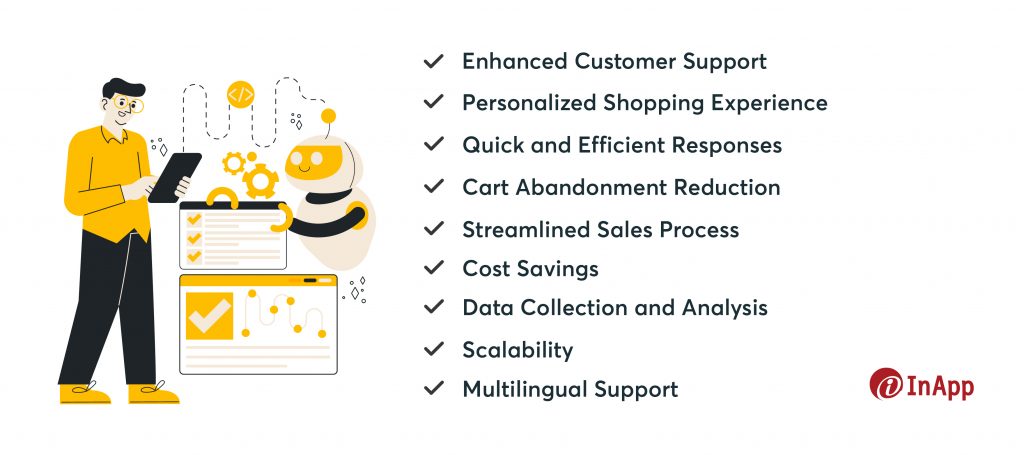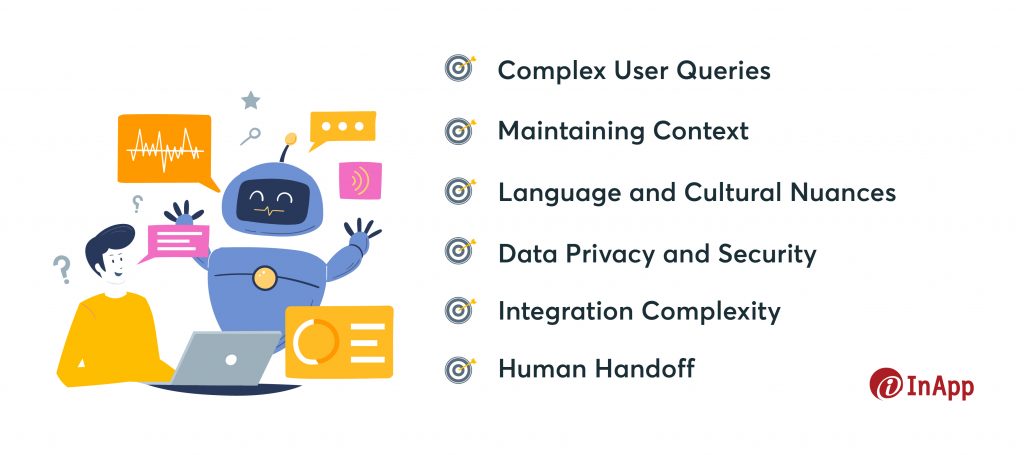E-commerce chatbots have taken the industry by swarm in 2023. According to Gartner, chatbots are poised to take center stage as the primary customer service tool for 25% of all companies by 2027.
This is a testament to their surging popularity and undeniable potential!
From churning out basic responses, e-commerce chatbots have today evolved into virtual assistants powered by advanced Artificial Intelligence. Today, these chatbots are not just answering questions instead, they are revolutionizing the way businesses engage with their customers.
What are E-commerce chatbots?
E-commerce chatbots are AI-powered chat platforms designed specifically for online shopping and e-commerce platforms. They interact with users and provide assistance, guidance, and support throughout the online shopping journey.
E-commerce chatbots can be broadly categorized into three categories
- AI-driven chatbots
- Rules-based chatbots
- Hybrid chatbots
AI-driven chatbots are the ones that utilize artificial intelligence (AI) and Natural Language Processing (NLP) to engage users in human-like conversations. They adapt and improve with each interaction, making them versatile for various industries and functions, from customer support to operational tasks.
In contrast, rules-based chatbots follow predefined decision trees and keyword recognition, lacking adaptability and learning capabilities. They are best suited for straightforward tasks and frequently asked questions, offering a quick deployment solution.
Hybrid chatbots strike a balance by combining predefined rules with AI enhancements. They efficiently handle routine queries using rules while employing AI for complex interactions, gradually learning and improving to provide a seamless and flexible user experience.
What are the benefits of E-commerce chatbots?
E-commerce chatbots, powered by artificial intelligence (AI) and natural language processing (NLP), offer numerous benefits for both businesses and consumers. Here are some of the key advantages of implementing e-commerce chatbots:

Enhanced Customer Support
E-commerce chatbots provide 24/7 customer support, ensuring that customers get assistance at any time. They can answer frequently asked questions, address common issues, and guide users through the purchasing process. This availability improves customer satisfaction and reduces the need for human customer support agents during non-business hours.
Personalized Shopping Experience
Chatbots can analyze user data and purchase history to offer personalized product recommendations. By understanding customer preferences, chatbots can suggest relevant products, promotions, and discounts, leading to increased sales and customer engagement. This level of personalization enhances the overall shopping experience.
Quick and Efficient Responses
Chatbots offer instant responses to customer inquiries, reducing wait times and frustration. They can handle multiple conversations simultaneously, ensuring that customers do not have to wait in long queues or on hold. Speedy responses improve user experience and increase the likelihood of conversion.
Cart Abandonment Reduction
E-commerce chatbots can identify when a user abandons their shopping cart and send automated reminders or incentives to encourage the completion of the purchase. This helps recover potentially lost sales and boosts revenue for online retailers.
Streamlined Sales Process
Chatbots can guide users through the sales funnel, from product discovery to checkout. They can answer questions about product details, pricing, and availability, making the purchasing process smoother and more efficient. This reduces friction and cart abandonment rates.
Cost Savings
E-commerce chatbots can significantly reduce operational costs by automating customer support and routine tasks. Businesses can allocate human resources to more complex tasks while the chatbot handles repetitive inquiries, resulting in cost savings over time.
Data Collection and Analysis
Chatbots can gather valuable customer data during interactions. This data can be used to analyze user behavior, preferences, and trends. Businesses can leverage these insights to refine their marketing strategies, product offerings, and customer service approaches.
Scalability
E-commerce chatbots can handle a high volume of customer interactions simultaneously, making them scalable for businesses of all sizes. Whether a company is a small startup or a large enterprise, chatbots can adapt to the demand.
Multilingual Support
E-commerce chatbots can communicate in multiple languages, allowing businesses to cater to a global audience without the need for a large multilingual support team. This expands the market reach and potential customer base.
Challenges of E-commerce Chatbots
While e-commerce chatbots offer numerous advantages, they also come with several challenges that businesses must address for successful implementation.

Complex User Queries
E-commerce customers may have intricate questions or unique requests that go beyond the capabilities of chatbots. Handling complex inquiries and providing accurate responses can be a challenge, leading to potential frustration for users.
Maintaining Context
Chatbots need to maintain context within a conversation to provide coherent responses. However, they may struggle with context when users change topics or refer to previous messages, leading to disjointed interactions.
Language and Cultural Nuances
E-commerce chatbots need to understand and adapt to various languages, dialects, and cultural nuances, which can be challenging, especially in a global market. Misinterpretation or insensitivity in responses can harm user experience.
Data Privacy and Security
Handling customer data poses a significant challenge. E-commerce chatbots often collect and store user information, making them attractive targets for hackers. Ensuring robust data encryption and compliance with data privacy regulations is crucial.
Integration Complexity
Integrating chatbots into existing e-commerce platforms, databases, and CRM systems can be complex. It requires a seamless connection to provide users with accurate information about products, orders, and accounts.
Human Handoff
E-commerce chatbots may struggle to handle complex or emotional issues that require human intervention. Implementing a seamless transition from chatbot to human customer support agents when necessary is challenging but essential to maintaining customer satisfaction.
Despite these challenges, businesses can overcome them with careful planning, robust development, and continuous monitoring and improvement. E-commerce chatbots, when effectively implemented, can significantly enhance customer engagement and streamline online shopping experiences.
Why E-commerce Chatbots Are a Must-Have Investment for Your Business?
In the ever-evolving realm of e-commerce, meeting and exceeding customer expectations is paramount. Shoppers now demand seamless experiences, instant responses, and personalized interactions. E-commerce chatbots have emerged as indispensable tools for businesses, offering a multitude of advantages.
Investing in e-commerce chatbots is not a mere choice but a strategic necessity. These intelligent virtual assistants provide 24/7 customer support, increase sales and conversions, and deliver personalized, streamlined shopping experiences that foster customer loyalty.
Frequently Asked Questions
How to create a marketplace website?
To create a marketplace website, first, pick a platform like Shopify or WooCommerce. Get a domain and good hosting. Design a user-friendly site with features like user accounts and secure payment. Prioritize security and test the website thoroughly. Once everything checks out, launch the marketplace and promote it to attract users.
